Health Promotion Plan Essay 2022
VerifiedAdded on 2022/09/14
|7
|1514
|11
Essay
AI Summary
Contribute Materials
Your contribution can guide someone’s learning journey. Share your
documents today.
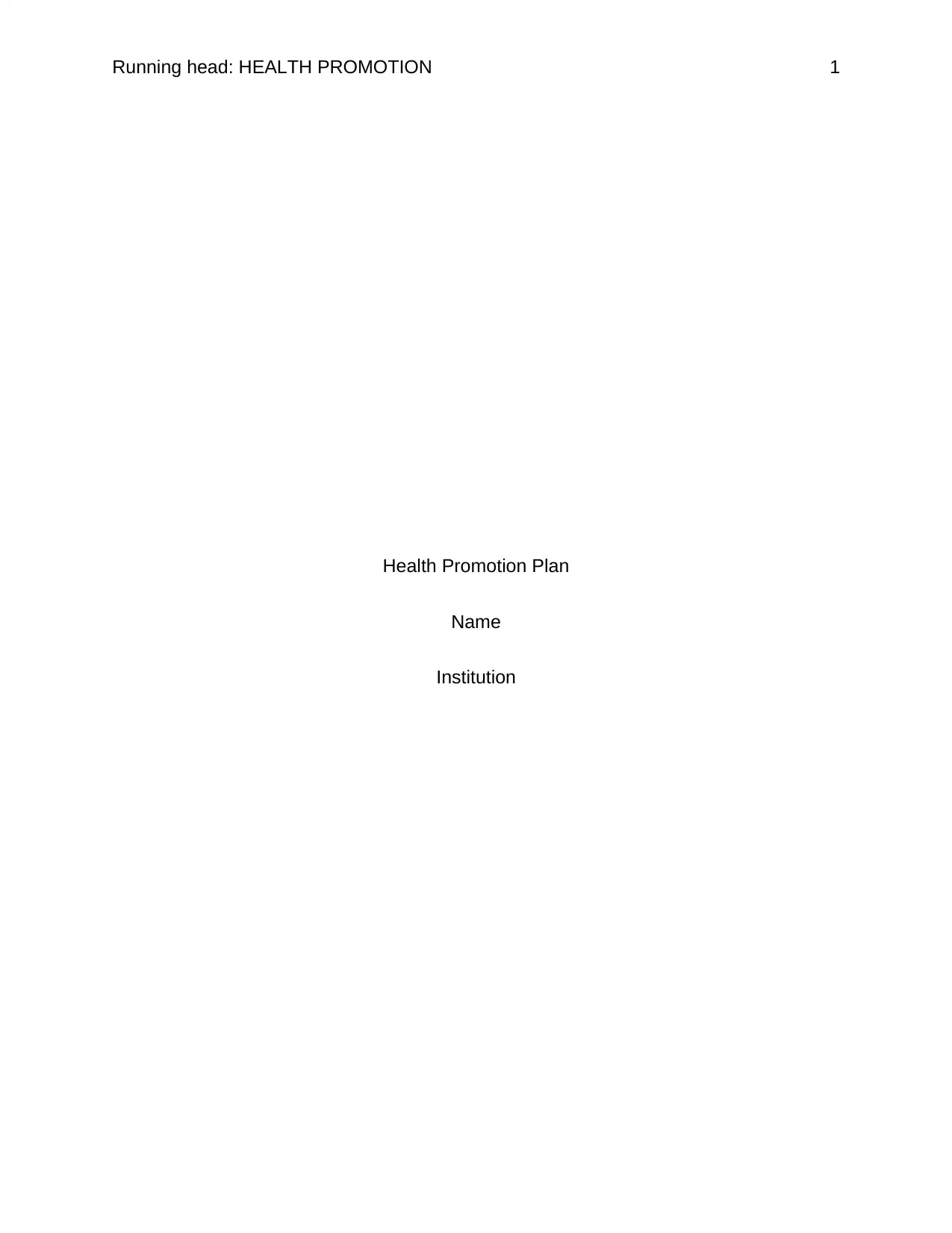
Running head: HEALTH PROMOTION 1
Health Promotion Plan
Name
Institution
Health Promotion Plan
Name
Institution
Secure Best Marks with AI Grader
Need help grading? Try our AI Grader for instant feedback on your assignments.
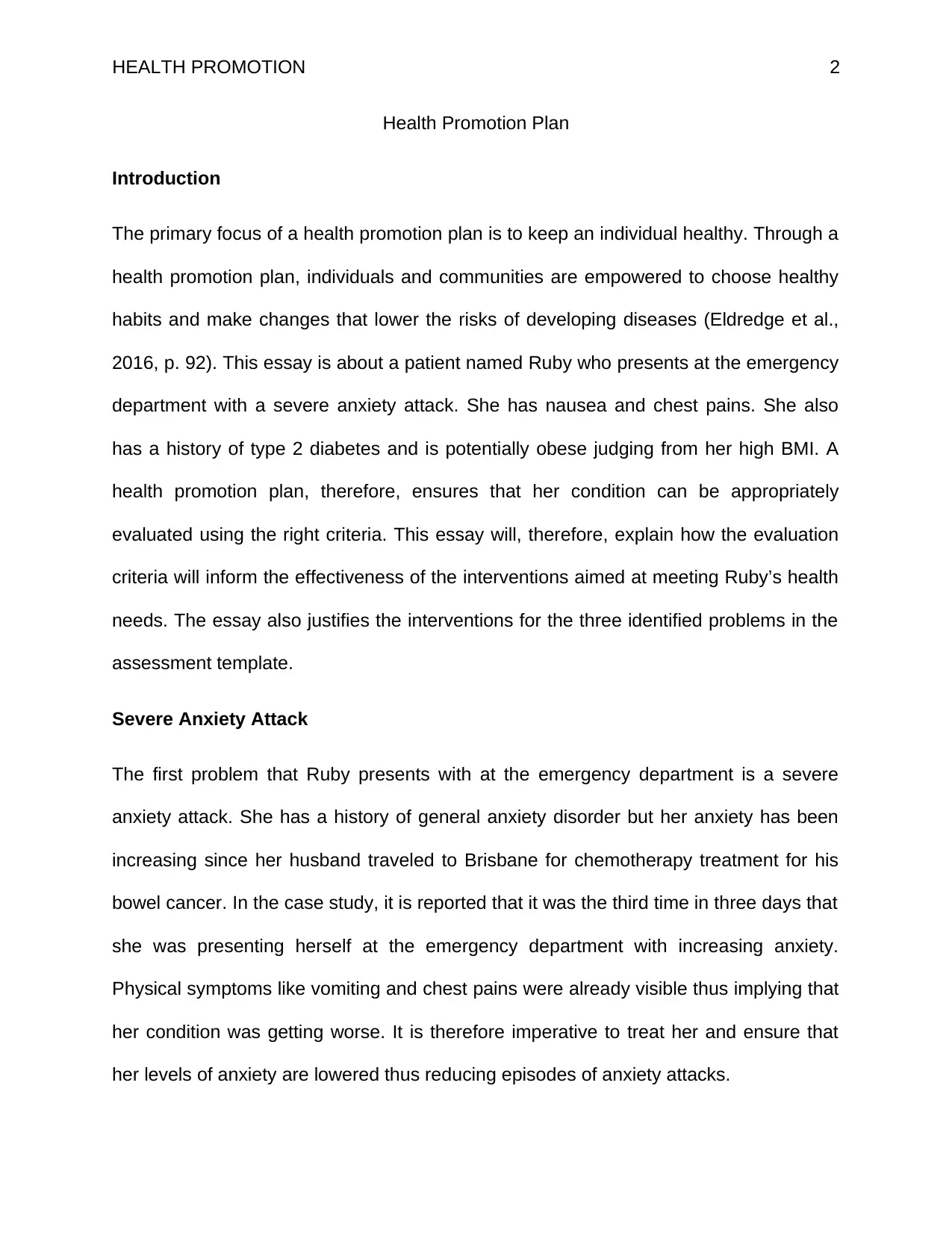
HEALTH PROMOTION 2
Health Promotion Plan
Introduction
The primary focus of a health promotion plan is to keep an individual healthy. Through a
health promotion plan, individuals and communities are empowered to choose healthy
habits and make changes that lower the risks of developing diseases (Eldredge et al.,
2016, p. 92). This essay is about a patient named Ruby who presents at the emergency
department with a severe anxiety attack. She has nausea and chest pains. She also
has a history of type 2 diabetes and is potentially obese judging from her high BMI. A
health promotion plan, therefore, ensures that her condition can be appropriately
evaluated using the right criteria. This essay will, therefore, explain how the evaluation
criteria will inform the effectiveness of the interventions aimed at meeting Ruby’s health
needs. The essay also justifies the interventions for the three identified problems in the
assessment template.
Severe Anxiety Attack
The first problem that Ruby presents with at the emergency department is a severe
anxiety attack. She has a history of general anxiety disorder but her anxiety has been
increasing since her husband traveled to Brisbane for chemotherapy treatment for his
bowel cancer. In the case study, it is reported that it was the third time in three days that
she was presenting herself at the emergency department with increasing anxiety.
Physical symptoms like vomiting and chest pains were already visible thus implying that
her condition was getting worse. It is therefore imperative to treat her and ensure that
her levels of anxiety are lowered thus reducing episodes of anxiety attacks.
Health Promotion Plan
Introduction
The primary focus of a health promotion plan is to keep an individual healthy. Through a
health promotion plan, individuals and communities are empowered to choose healthy
habits and make changes that lower the risks of developing diseases (Eldredge et al.,
2016, p. 92). This essay is about a patient named Ruby who presents at the emergency
department with a severe anxiety attack. She has nausea and chest pains. She also
has a history of type 2 diabetes and is potentially obese judging from her high BMI. A
health promotion plan, therefore, ensures that her condition can be appropriately
evaluated using the right criteria. This essay will, therefore, explain how the evaluation
criteria will inform the effectiveness of the interventions aimed at meeting Ruby’s health
needs. The essay also justifies the interventions for the three identified problems in the
assessment template.
Severe Anxiety Attack
The first problem that Ruby presents with at the emergency department is a severe
anxiety attack. She has a history of general anxiety disorder but her anxiety has been
increasing since her husband traveled to Brisbane for chemotherapy treatment for his
bowel cancer. In the case study, it is reported that it was the third time in three days that
she was presenting herself at the emergency department with increasing anxiety.
Physical symptoms like vomiting and chest pains were already visible thus implying that
her condition was getting worse. It is therefore imperative to treat her and ensure that
her levels of anxiety are lowered thus reducing episodes of anxiety attacks.
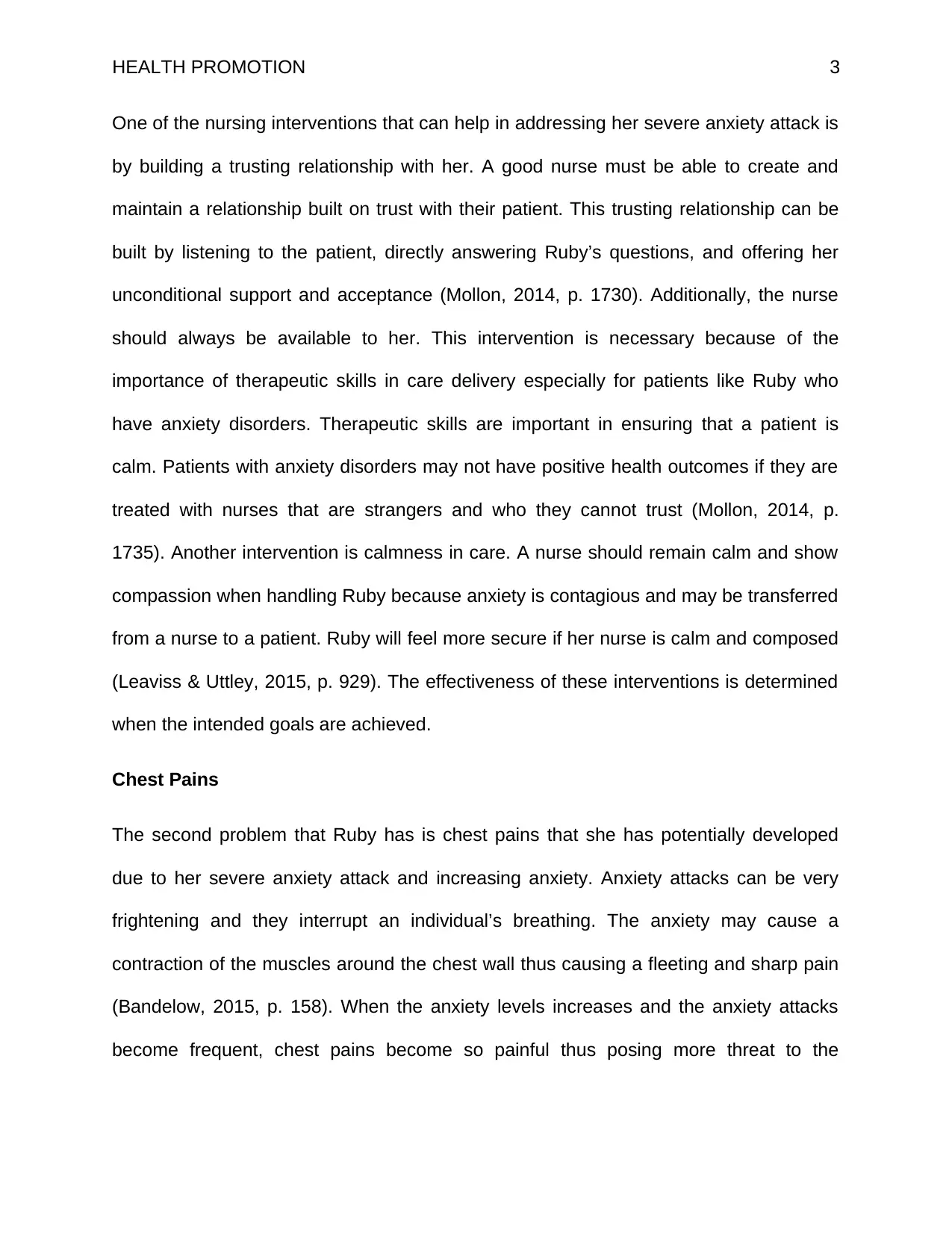
HEALTH PROMOTION 3
One of the nursing interventions that can help in addressing her severe anxiety attack is
by building a trusting relationship with her. A good nurse must be able to create and
maintain a relationship built on trust with their patient. This trusting relationship can be
built by listening to the patient, directly answering Ruby’s questions, and offering her
unconditional support and acceptance (Mollon, 2014, p. 1730). Additionally, the nurse
should always be available to her. This intervention is necessary because of the
importance of therapeutic skills in care delivery especially for patients like Ruby who
have anxiety disorders. Therapeutic skills are important in ensuring that a patient is
calm. Patients with anxiety disorders may not have positive health outcomes if they are
treated with nurses that are strangers and who they cannot trust (Mollon, 2014, p.
1735). Another intervention is calmness in care. A nurse should remain calm and show
compassion when handling Ruby because anxiety is contagious and may be transferred
from a nurse to a patient. Ruby will feel more secure if her nurse is calm and composed
(Leaviss & Uttley, 2015, p. 929). The effectiveness of these interventions is determined
when the intended goals are achieved.
Chest Pains
The second problem that Ruby has is chest pains that she has potentially developed
due to her severe anxiety attack and increasing anxiety. Anxiety attacks can be very
frightening and they interrupt an individual’s breathing. The anxiety may cause a
contraction of the muscles around the chest wall thus causing a fleeting and sharp pain
(Bandelow, 2015, p. 158). When the anxiety levels increases and the anxiety attacks
become frequent, chest pains become so painful thus posing more threat to the
One of the nursing interventions that can help in addressing her severe anxiety attack is
by building a trusting relationship with her. A good nurse must be able to create and
maintain a relationship built on trust with their patient. This trusting relationship can be
built by listening to the patient, directly answering Ruby’s questions, and offering her
unconditional support and acceptance (Mollon, 2014, p. 1730). Additionally, the nurse
should always be available to her. This intervention is necessary because of the
importance of therapeutic skills in care delivery especially for patients like Ruby who
have anxiety disorders. Therapeutic skills are important in ensuring that a patient is
calm. Patients with anxiety disorders may not have positive health outcomes if they are
treated with nurses that are strangers and who they cannot trust (Mollon, 2014, p.
1735). Another intervention is calmness in care. A nurse should remain calm and show
compassion when handling Ruby because anxiety is contagious and may be transferred
from a nurse to a patient. Ruby will feel more secure if her nurse is calm and composed
(Leaviss & Uttley, 2015, p. 929). The effectiveness of these interventions is determined
when the intended goals are achieved.
Chest Pains
The second problem that Ruby has is chest pains that she has potentially developed
due to her severe anxiety attack and increasing anxiety. Anxiety attacks can be very
frightening and they interrupt an individual’s breathing. The anxiety may cause a
contraction of the muscles around the chest wall thus causing a fleeting and sharp pain
(Bandelow, 2015, p. 158). When the anxiety levels increases and the anxiety attacks
become frequent, chest pains become so painful thus posing more threat to the
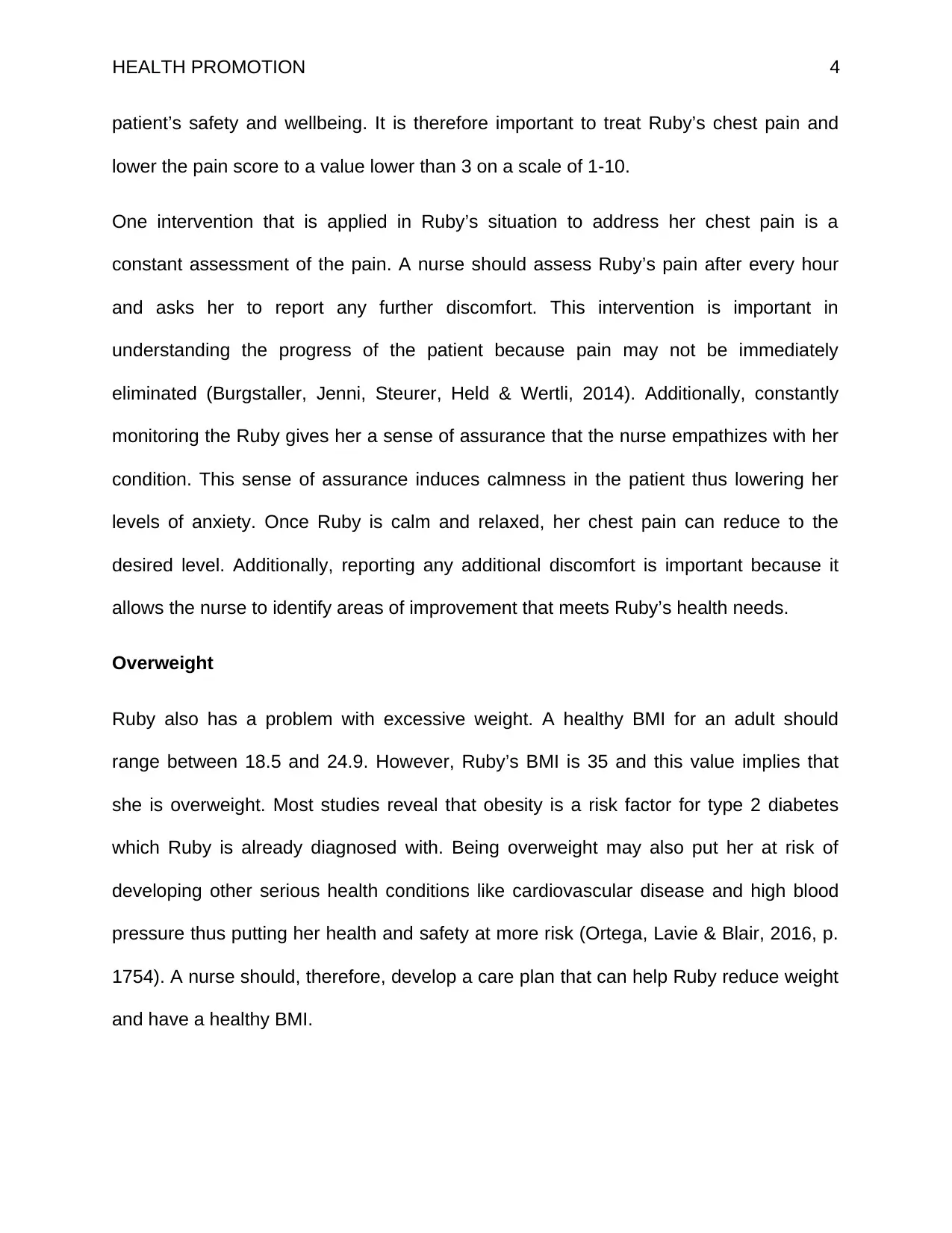
HEALTH PROMOTION 4
patient’s safety and wellbeing. It is therefore important to treat Ruby’s chest pain and
lower the pain score to a value lower than 3 on a scale of 1-10.
One intervention that is applied in Ruby’s situation to address her chest pain is a
constant assessment of the pain. A nurse should assess Ruby’s pain after every hour
and asks her to report any further discomfort. This intervention is important in
understanding the progress of the patient because pain may not be immediately
eliminated (Burgstaller, Jenni, Steurer, Held & Wertli, 2014). Additionally, constantly
monitoring the Ruby gives her a sense of assurance that the nurse empathizes with her
condition. This sense of assurance induces calmness in the patient thus lowering her
levels of anxiety. Once Ruby is calm and relaxed, her chest pain can reduce to the
desired level. Additionally, reporting any additional discomfort is important because it
allows the nurse to identify areas of improvement that meets Ruby’s health needs.
Overweight
Ruby also has a problem with excessive weight. A healthy BMI for an adult should
range between 18.5 and 24.9. However, Ruby’s BMI is 35 and this value implies that
she is overweight. Most studies reveal that obesity is a risk factor for type 2 diabetes
which Ruby is already diagnosed with. Being overweight may also put her at risk of
developing other serious health conditions like cardiovascular disease and high blood
pressure thus putting her health and safety at more risk (Ortega, Lavie & Blair, 2016, p.
1754). A nurse should, therefore, develop a care plan that can help Ruby reduce weight
and have a healthy BMI.
patient’s safety and wellbeing. It is therefore important to treat Ruby’s chest pain and
lower the pain score to a value lower than 3 on a scale of 1-10.
One intervention that is applied in Ruby’s situation to address her chest pain is a
constant assessment of the pain. A nurse should assess Ruby’s pain after every hour
and asks her to report any further discomfort. This intervention is important in
understanding the progress of the patient because pain may not be immediately
eliminated (Burgstaller, Jenni, Steurer, Held & Wertli, 2014). Additionally, constantly
monitoring the Ruby gives her a sense of assurance that the nurse empathizes with her
condition. This sense of assurance induces calmness in the patient thus lowering her
levels of anxiety. Once Ruby is calm and relaxed, her chest pain can reduce to the
desired level. Additionally, reporting any additional discomfort is important because it
allows the nurse to identify areas of improvement that meets Ruby’s health needs.
Overweight
Ruby also has a problem with excessive weight. A healthy BMI for an adult should
range between 18.5 and 24.9. However, Ruby’s BMI is 35 and this value implies that
she is overweight. Most studies reveal that obesity is a risk factor for type 2 diabetes
which Ruby is already diagnosed with. Being overweight may also put her at risk of
developing other serious health conditions like cardiovascular disease and high blood
pressure thus putting her health and safety at more risk (Ortega, Lavie & Blair, 2016, p.
1754). A nurse should, therefore, develop a care plan that can help Ruby reduce weight
and have a healthy BMI.
Secure Best Marks with AI Grader
Need help grading? Try our AI Grader for instant feedback on your assignments.
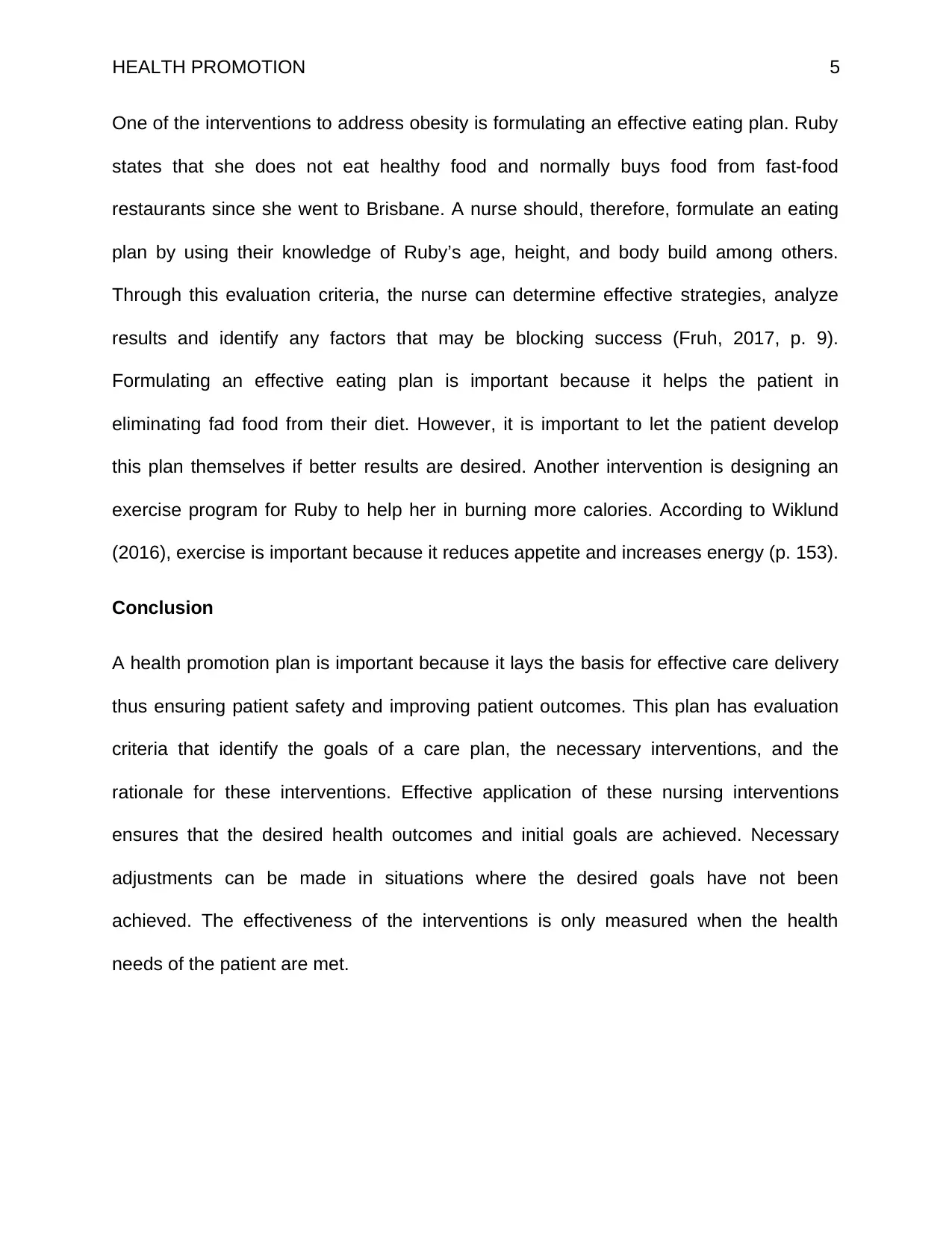
HEALTH PROMOTION 5
One of the interventions to address obesity is formulating an effective eating plan. Ruby
states that she does not eat healthy food and normally buys food from fast-food
restaurants since she went to Brisbane. A nurse should, therefore, formulate an eating
plan by using their knowledge of Ruby’s age, height, and body build among others.
Through this evaluation criteria, the nurse can determine effective strategies, analyze
results and identify any factors that may be blocking success (Fruh, 2017, p. 9).
Formulating an effective eating plan is important because it helps the patient in
eliminating fad food from their diet. However, it is important to let the patient develop
this plan themselves if better results are desired. Another intervention is designing an
exercise program for Ruby to help her in burning more calories. According to Wiklund
(2016), exercise is important because it reduces appetite and increases energy (p. 153).
Conclusion
A health promotion plan is important because it lays the basis for effective care delivery
thus ensuring patient safety and improving patient outcomes. This plan has evaluation
criteria that identify the goals of a care plan, the necessary interventions, and the
rationale for these interventions. Effective application of these nursing interventions
ensures that the desired health outcomes and initial goals are achieved. Necessary
adjustments can be made in situations where the desired goals have not been
achieved. The effectiveness of the interventions is only measured when the health
needs of the patient are met.
One of the interventions to address obesity is formulating an effective eating plan. Ruby
states that she does not eat healthy food and normally buys food from fast-food
restaurants since she went to Brisbane. A nurse should, therefore, formulate an eating
plan by using their knowledge of Ruby’s age, height, and body build among others.
Through this evaluation criteria, the nurse can determine effective strategies, analyze
results and identify any factors that may be blocking success (Fruh, 2017, p. 9).
Formulating an effective eating plan is important because it helps the patient in
eliminating fad food from their diet. However, it is important to let the patient develop
this plan themselves if better results are desired. Another intervention is designing an
exercise program for Ruby to help her in burning more calories. According to Wiklund
(2016), exercise is important because it reduces appetite and increases energy (p. 153).
Conclusion
A health promotion plan is important because it lays the basis for effective care delivery
thus ensuring patient safety and improving patient outcomes. This plan has evaluation
criteria that identify the goals of a care plan, the necessary interventions, and the
rationale for these interventions. Effective application of these nursing interventions
ensures that the desired health outcomes and initial goals are achieved. Necessary
adjustments can be made in situations where the desired goals have not been
achieved. The effectiveness of the interventions is only measured when the health
needs of the patient are met.
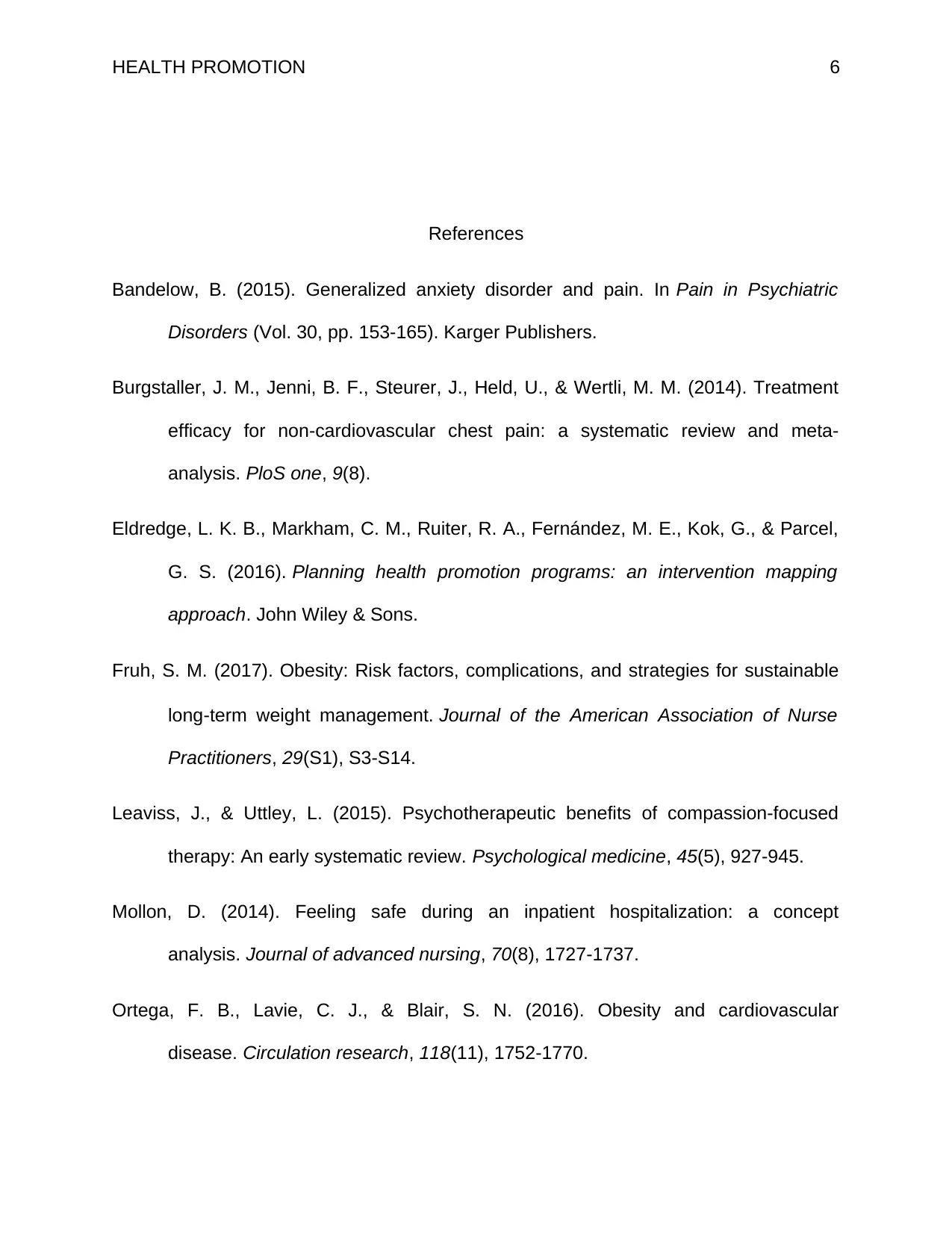
HEALTH PROMOTION 6
References
Bandelow, B. (2015). Generalized anxiety disorder and pain. In Pain in Psychiatric
Disorders (Vol. 30, pp. 153-165). Karger Publishers.
Burgstaller, J. M., Jenni, B. F., Steurer, J., Held, U., & Wertli, M. M. (2014). Treatment
efficacy for non-cardiovascular chest pain: a systematic review and meta-
analysis. PloS one, 9(8).
Eldredge, L. K. B., Markham, C. M., Ruiter, R. A., Fernández, M. E., Kok, G., & Parcel,
G. S. (2016). Planning health promotion programs: an intervention mapping
approach. John Wiley & Sons.
Fruh, S. M. (2017). Obesity: Risk factors, complications, and strategies for sustainable
long‐term weight management. Journal of the American Association of Nurse
Practitioners, 29(S1), S3-S14.
Leaviss, J., & Uttley, L. (2015). Psychotherapeutic benefits of compassion-focused
therapy: An early systematic review. Psychological medicine, 45(5), 927-945.
Mollon, D. (2014). Feeling safe during an inpatient hospitalization: a concept
analysis. Journal of advanced nursing, 70(8), 1727-1737.
Ortega, F. B., Lavie, C. J., & Blair, S. N. (2016). Obesity and cardiovascular
disease. Circulation research, 118(11), 1752-1770.
References
Bandelow, B. (2015). Generalized anxiety disorder and pain. In Pain in Psychiatric
Disorders (Vol. 30, pp. 153-165). Karger Publishers.
Burgstaller, J. M., Jenni, B. F., Steurer, J., Held, U., & Wertli, M. M. (2014). Treatment
efficacy for non-cardiovascular chest pain: a systematic review and meta-
analysis. PloS one, 9(8).
Eldredge, L. K. B., Markham, C. M., Ruiter, R. A., Fernández, M. E., Kok, G., & Parcel,
G. S. (2016). Planning health promotion programs: an intervention mapping
approach. John Wiley & Sons.
Fruh, S. M. (2017). Obesity: Risk factors, complications, and strategies for sustainable
long‐term weight management. Journal of the American Association of Nurse
Practitioners, 29(S1), S3-S14.
Leaviss, J., & Uttley, L. (2015). Psychotherapeutic benefits of compassion-focused
therapy: An early systematic review. Psychological medicine, 45(5), 927-945.
Mollon, D. (2014). Feeling safe during an inpatient hospitalization: a concept
analysis. Journal of advanced nursing, 70(8), 1727-1737.
Ortega, F. B., Lavie, C. J., & Blair, S. N. (2016). Obesity and cardiovascular
disease. Circulation research, 118(11), 1752-1770.
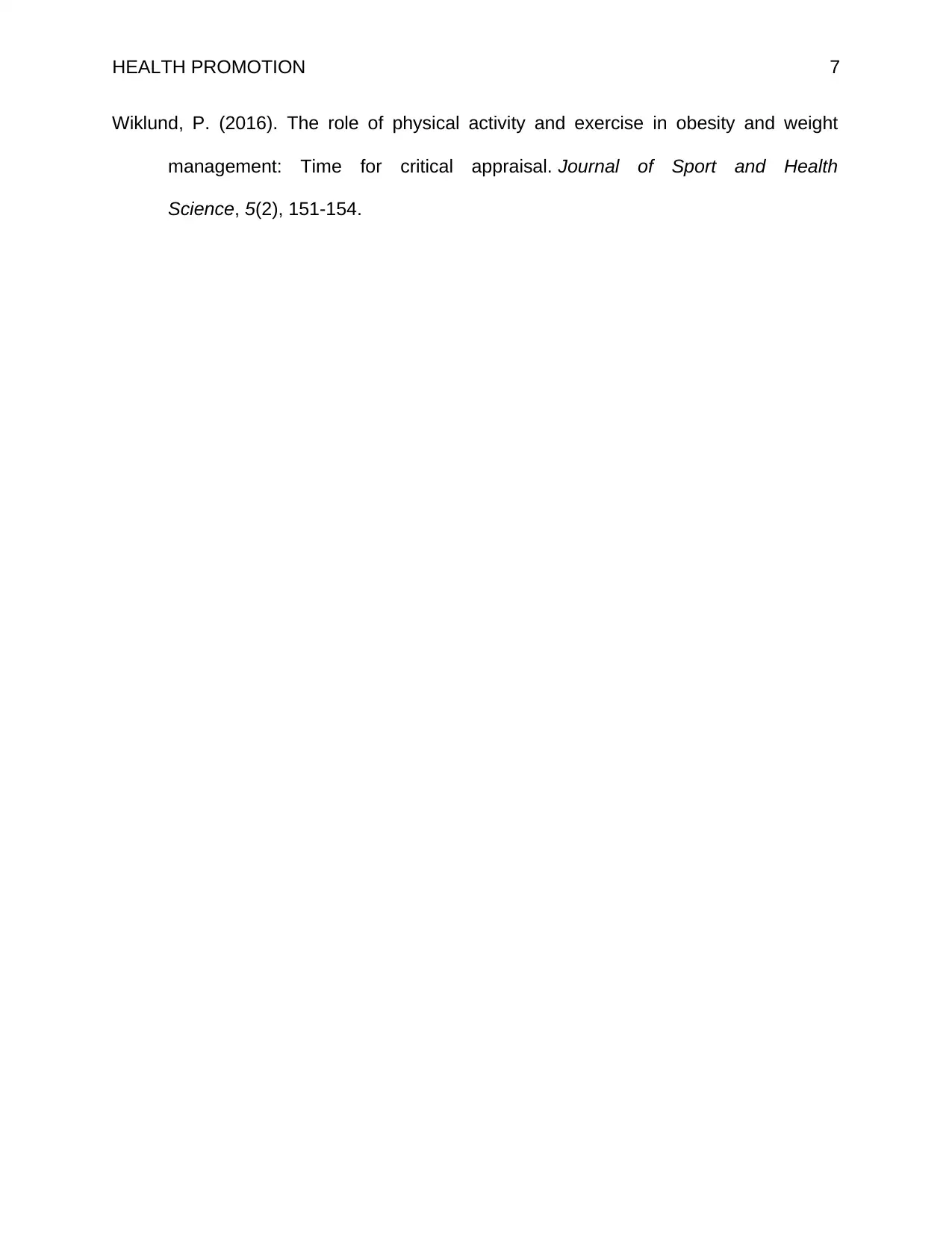
HEALTH PROMOTION 7
Wiklund, P. (2016). The role of physical activity and exercise in obesity and weight
management: Time for critical appraisal. Journal of Sport and Health
Science, 5(2), 151-154.
Wiklund, P. (2016). The role of physical activity and exercise in obesity and weight
management: Time for critical appraisal. Journal of Sport and Health
Science, 5(2), 151-154.
1 out of 7
Related Documents
Your All-in-One AI-Powered Toolkit for Academic Success.
+13062052269
info@desklib.com
Available 24*7 on WhatsApp / Email
![[object Object]](/_next/static/media/star-bottom.7253800d.svg)
Unlock your academic potential
© 2024 | Zucol Services PVT LTD | All rights reserved.





